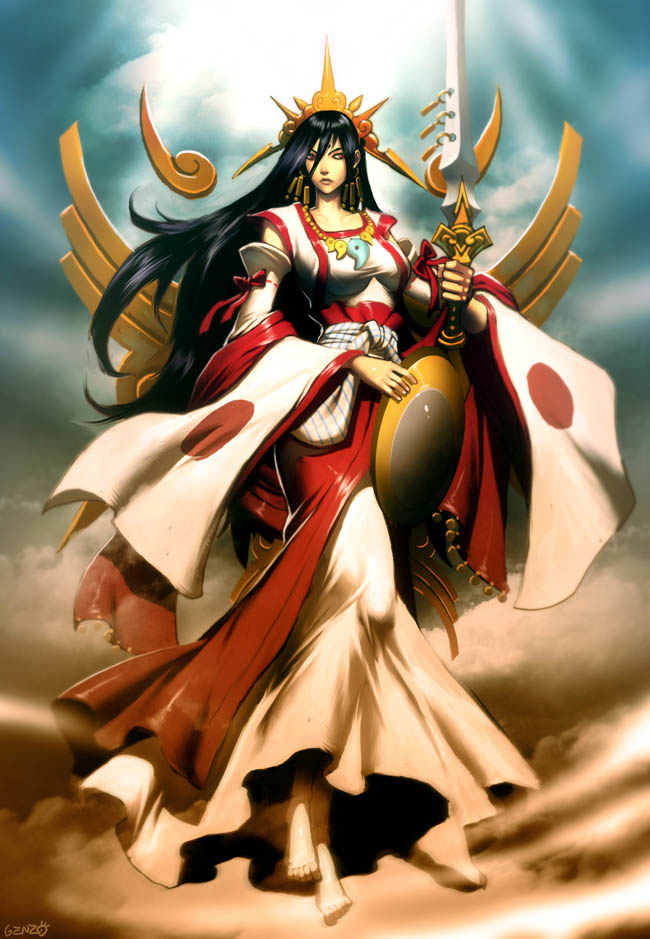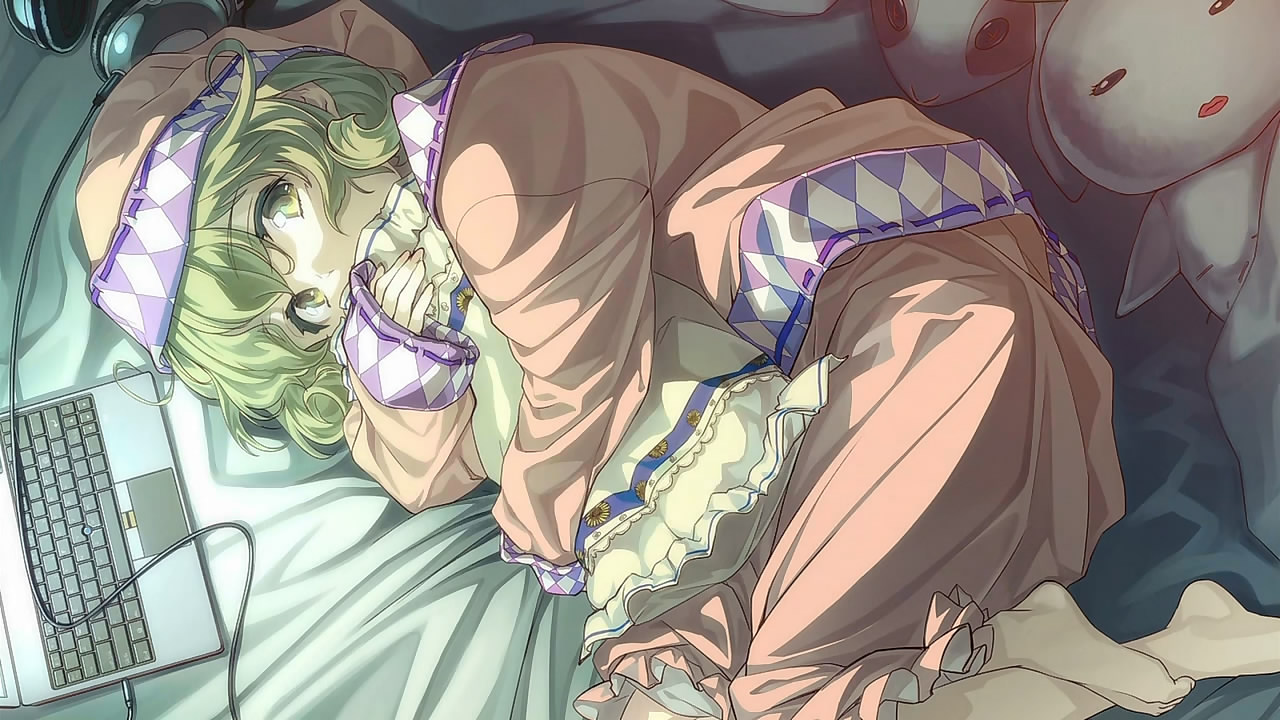
In Japan, there is a certain goddess. A pillar of righteousness, she sits high in the heavens, casting her light down upon everything beneath her. Countless other gods, enraptured by her splendor and majesty, hurry about trying to cull favor from this radiant maiden of unearthly beauty. Her name is Amaterasu, the embodiment of the sun itself, ancestor of the imperial family, and possessor of the supreme power of all kami: ready to defend her people at a moment’s notice against evil and ever vigilant in her watch over all those beneath her.
At least until her favorite anime comes on. Then, you’re s-o-l.
A playful entry into the winter 2013 anime season, SHAFT’s Sasami-san@ganbaranai (Ms Sasami @ Unmotivated) is an alternate take on the legend of the sun goddess, told from the point of a cute, hikikomori schoolgirl and her faceless brother. But while the legend of Amaterasu is a tale of bullying, retreat and the eventual emergence of the brilliance of the sun, Sasami’s story is a little more…relatable? Typical? Expected? Actually, it’s hard to put into words.
 By day, the spunky Sasami Tsukuyomi is content to lounge around, taking time out of her busy schedule of gaming and sleeping to spy on her elder brother while he works his job at the local high school she should be attending. By night, she demands that he profess his love to her, feed her, wash her and put her to bed, so the following day she can repeat the process. Punish his supposed ecchi moments, act aloof until he’s swooning, and deflect his advances continuously. Not too different from any pampered princess living out her daily dreams of not doing anything.
By day, the spunky Sasami Tsukuyomi is content to lounge around, taking time out of her busy schedule of gaming and sleeping to spy on her elder brother while he works his job at the local high school she should be attending. By night, she demands that he profess his love to her, feed her, wash her and put her to bed, so the following day she can repeat the process. Punish his supposed ecchi moments, act aloof until he’s swooning, and deflect his advances continuously. Not too different from any pampered princess living out her daily dreams of not doing anything.
But Sasami is different. Unlike a mere mortal royal, she is the heir to the power of the sun itself, and with it has the ability to force anyone – god or human alike – to do her “bidding,” those wishes she has in her heart that she rarely vocalizes. These “transformations” come back to haunt her time and again, but still she resists, preferring the life of a shut in to that of a responsible person. For shame, denying the obligations of the mighty sun goddess- she would never do such a…oh…OH!, I get it now. Clever girl…
From the outset, Sasami-san@ganbaranai borrows liberally from the legend of the “original hikikomori,” Amaterasu. In the legends, the maiden of the sun is driven underground by her brother, the “vile” Susano-o. Taking refuge in a cave, she refuses to come back out, depriving the world of her radiance and allowing for monsters to run rampant. Some clever and enterprising folks manage to use her own envy against her, convincing her (through the use of several well-placed mirrors) that they have chosen a new sun goddess, and luring her back out. From then on her, place remains in the sky, driving off ghostly spirits and giving light to the people. All that’s missing here is the computers.

Sasami, the heir of this cosmic power, lives her life indoors. Every time she attempts to leave the house, a powerful wave of nausea and disorientations overtakes her. She retreats back inside. She finds amusement in petty things. She can’t take care of herself. And her brother, kami bless, him, dotes on her unceasingly. Continue along this path until forced to leave, in order to protect the brother she realizes she loves, from sacrificing himself for her. Not a word-for-word updating of the original tale, but close enough to provide a cute, modern insight into the source material. (Even cuter when you realize her faceless bother Kamiomi is Tsuki-yomi, the “faceless” god of the moon- ever present, ever mysterious, ever-doting…well, maybe that last part is a stretch.)
Of course, her brother is “assisted” in his duties by three “sisters,” the Yagamis, who are themselves human incarnations of the three regalia of Japan – the mirror, the sword and the “jewel” – tasked with assisting in Sasami’s “upkeep” and making sure the transformations she seems to throw around like proverbial candy don’t come back to take a bite out of HER. Each sister, from the innocent, yet still oddly busty, Tama, to the almost mecha-musume Kagami, to the slightly skewed Tsurugi (also a teacher at Sasami’s high school), play important roles in maintaining a balance between the real world and Sasami’s whims. Each one also plays a deeper role than even Sasami realizes, though saying anything else would be spoilers.
On the surface, Sasami-san@ganbaranai feels a lot like a certain other moe-style show from a few years ago: a light novel series about girl seeking something more from life, subconsciously gains the power to influence reality to meet her desires, then needs to be “saved” by a cadre of fellow students brought together because of her existence and affect on cosmic balance…we’ve heard all this before…
The difference between Sasami and Haruhi, however, lies in the fact that unlike the latter, she isn’t an arrogant (at least not too much), relatively unlikable tsundere forcing her interests on others. In fact, Sasami is more innocent, perhaps even sweeter, than Haruhi Suzumiya ever could be. And that innocence makes her character far more interesting and relatable. When she makes a mistake, she tries to fix it. When she realizes how her actions impact those she loves, she attempts to make amends. And unlike Haruhi, she eventually gains a full understanding of what she is, and grows from it.
I’m going to go out on a limb here and say that Sasami-san@ganbaranai is the moe show I’ve been looking for. More fun than Jintai, a better use of folklore than Inu X Boku and at times sillier than Haiyore!, this is the kind of show I’d expect from SHAFT: nothing groundbreaking, but a better use of tropes and narrative than simply cute girls doing cute things. A solid entry for winter season, and enough to tide one over until the spring.


